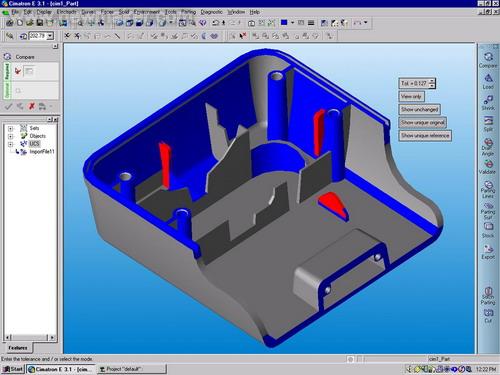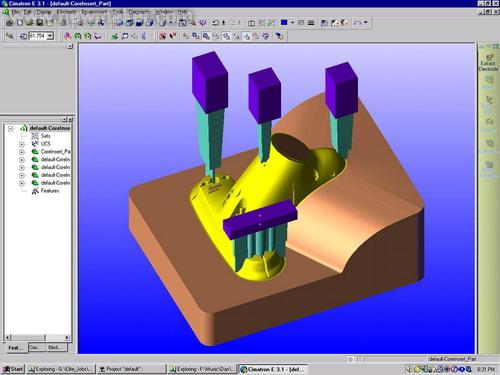Listening to users is an important guideline in any industry. Moldmakers are very frustrated with their current work, and they are very eager to automate their day-to-day work and are very concerned about innovations in tooling manufacturing. They want to automate repetitive monotony work with only solid modeling capabilities, and they require powerful modeling capabilities so they can control changes to completed work at any time. Toolmakers are often told that engineering changes will only "affect certain areas," but when they are cautiously analyzed, other parts are also affected. Thus, time-saving, efficient methods have huge business opportunities.
There are three factors that limit the mold manufacturer's implementation of any solution. First, the tool and die manufacturing industry relies on multiple suppliers, but the necessary tools are missing from these suppliers for real-time coordination. Second, the use of multiple software products, tooling design and processing processes are at any stage. The need for data conversion; third, a system that can complete the design from concept to tooling and final processing requires the most basic solid modeling technology. There is currently a way to cope with this inevitable engineering change: avoiding the problems caused by the need for data conversion and complex surfaces (the most advanced solid modeling is not replaceable) in the tooling manufacturing industry (IGES, STEP, VDA, etc.). The data for most tooling models is obtained from upstream customers. Typically, discrete surfaces are formed when data is introduced into the system. From this point of view, what is needed to make a complex tooling is software that can edit each surface and edit the entire topology geometry. Powerful software tools need to have the following functions: surface patching, restoration, closing gaps, modification, adding drafts, generating fillets/transitions, parting lines, and parting surfaces. Cimatron has developed Cimatron E with innovative technology that eliminates the need to generate fully enclosed entities during current data processing. Open entities can be processed throughout the process while handling closed and open surfaces. Mixture. When toolmakers perform Boolean operations on discrete surfaces to create cores/cavities, Cimatron E provides two methods for stitching discrete surfaces together or directly performing operations on the entire model. There is no need to stitch discrete surfaces. The model of the final result is fully correlated. Design changes exist at any stage of the design process, and toolmakers must process these changes in a timely and efficient manner. The closer to the end of the project, the greater the time and money lost due to the change. If every stage of the work can read in new data and automatically update the output, the entire design process can be automatically updated after the design change. This process is implemented by requiring different application software to have geometric data in a consistent data format, as well as shared related features. The older generation of solid modeling systems can only implement design changes when dealing with data in their own format, a situation that is not easily realized in today's tooling industry. Once design changes are inevitable, new data has to be annotated and distributed to each work department. The entire work process must analyze new data and determine the impact of new data on the process. Tool mold makers know that engineering changes (ECO) are an inevitable part of their work. Even if users communicate design changes in strict data, potential errors often occur. To help toolmakers, we have developed a new tool that automatically digitizes the data of two models, identifies the differences between the two models, and reflects the differences in the form of a graphic, in the form of a file. Express the changes. (Figure 2) Cimatron's QuickCompare tool allows toolmakers to automatically update related components and processes to ultimately achieve design changes. The long-term, uncertain CAD design process is simplified to a process that provides clear results and easy management of information in a fraction of a second.
Cimatron's QuickElectrode tool is another example of a process-oriented solution – a solution for the automatic extraction, modeling, documentation and machining of electrodes. The electrical discharge machining (EDM) process achieves the desired shape by corroding the metal, and various physical factors limit our ability to increase the speed of the process itself. QuickElectrode quickly extracts the electrode part information from the front-end CAD stage, generates a parting surface, determines a blank, electrode base, chuck, and then determines the discharge part, while generating electrode drawings. The software reduces the entire amount as much as possible. The time required for the electrical discharge machining process. By using a fast electrode (QuickElectrode, as shown in Figure 3), the entire electrode design can be automated and optimized. This application software provides a database of CAD, CAM files and complete ISO 9001 and QS9000 documents (including automatic plotting). It can define the discharge surface, process the electrode surface of the discharge surface, and design the electrode. The template automates the electrode design process and automates the electrode documentation.
The use of a full-process solution not only enables manufacturers to successfully complete all aspects of their design work, but also allows them to avoid duplication of effort. In this way, the engineers' skills can be applied to the creative part of the process, rather than wasted on trivial matters. If manufacturers can spend more of their time dealing with the difficulties in tooling, they can produce high-quality products that are less flawed. Of course, manufacturers don't expect CAD/CAM software to do all the work automatically, but there is a software that automates some of the work, leaving the makers with the space to create. Today, in all the work, the job that the manufacturer wants is to supervise, manage, and dominate the automated steps, rather than wasting their time on identifying, extracting, and generating the parting surfaces of the electrodes, and eliminating the need to To handle cumbersome, lengthy documents. With new "special process technology", software companies, hardware companies, machinery companies, and mold companies are all in a leading position in the market. Looking ahead to the industry's prospects, this simple design process eliminates bottlenecks that limit design capabilities and ultimately shortens manufacturing cycles and increases profits. |
With the development of food culture, from simple cooking tools, gradually evolved into both use and artistic value of household articles.The classification and function of kitchen knives are more and more detailed, from the era of a Kitchen Knife fighting the world, developed into today's special combination of knives.We can provide customers all over the world with the best quality and colorful Plastic handle utility knives,also we can customize different utility knives according to the living habits of different countries.
Kitchen Utility Knife Set,Table Knife With Pp Handle,Utility Knife With Colorful Handle,Plastic Handle Utility Knife
HONG TAO KITCHEN INDUSTRY CO.,LTD , https://www.htkitchenware.com



